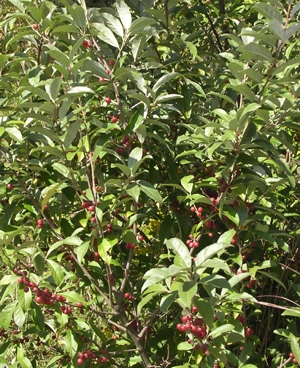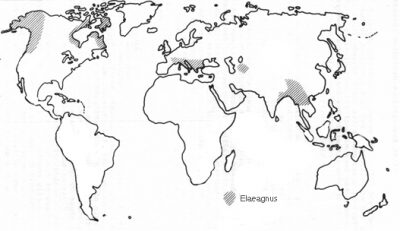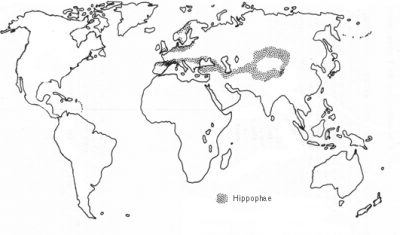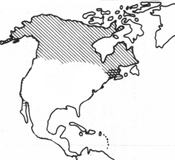

Elaeagnus umbellata in Connecticut (D.Benson)
E. commutata growing at a disturbed site (USDA-NRCS PLANTS Database)*
Elaeagnaceae Species |
||
| E. angustifolia L. (Russian olive) E. commutata Bernh. ex Rydb. (silverberry) E. multiflora Thunb. (cherry silverberry) |
E. umbellata Thunb. (autumn olive) E. pungens Thunb. (thorny olive) Hippophae rhamnoides L. (sea buckthorn) |
Shepherdia argentea (Pursh) Nutt. (silver buffaloberry) S. canadensis(L.) Nutt. (russet buffaloberry) S. rotundifolia Parry (roundleaf buffaloberry) |
(Ecology of the Elaeagnaceae symbioses)
Elaeagnus is found throughout North America and Eurasia, although some members of the genus have been widely cultivated and used in land reclamation outside their native range (Baker and Schwintzer, 1990). Elaeagnus has about 45 described species. Some species are invasive in Australia and western North America (Mabberely, 1988).

The number of species within Hippophae has been in dispute, with numbers ranging from one to seven with numerous subspecies (Bartish et al., 2002). Hippophae is native to central Asia, distributed from the North Sea to the Black Sea and east to the Himalayas.

Shepherdia is composed of three species, restricted to North America (Fig. 4. Mabberely, 1988).

The rbcL angiosperm phylogeny indicates that the Elaeagnaceae is close to the Rhamnaceae in the Rosales (Chase, et al., 1993; APG, 1998). Other phylogenetic studies place the Elaeagnaceae as sister to the Rhamnaceae, within the Rhamnaceae, or with the Barbeyaceae, Ulmaceae, and Cannabaceae (Richardson et al., 2000). In a tree constructed by Swensen (1996), Hippophae was sister to Elaeagnus and Shepherdia. The Elaeagnaceae appears late in the fossil record (Oligocene 22 - 39 mybp). The family most likely originated in Laurasia before the Northern Hemisphere continents separated (Bartish, et al., 2002).
Elaeagnus, Shepherdia and Hippophae spp. nodulate even in non-native soils or in soils that lack alternate hosts like Gymnostoma or Myrica. The Frankia strains present in root nodules belong to phylogenetic Cluster 3 (Benecke, 1969; Clawson, et al., 1998; Huguet, et al., 2001; Jamann, et al., 1992).
For a discussion of the ecological associations between the Elaeagnaceae and Frankia go to the Frankia Ecology page. For a discussion of the evolutionary relationships between plant and Frankia go to the Frankia Phylogeny and Plant Phylogeny pages.
*Image from (USDA-NRCS PLANTS Database / Herman, D.E. et al. 1996. North Dakota tree handbook. USDA NRCS ND State Soil Conservation Committee; NDSU Extension and Western Area Power Admin., Bismarck, ND. )